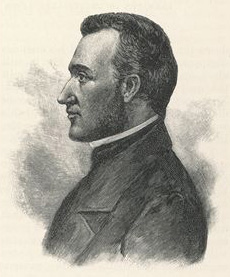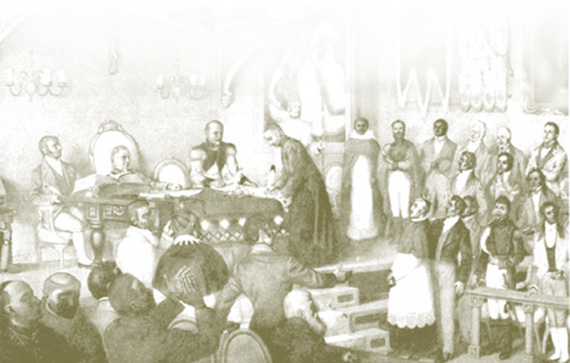|
Hubo un tiempo en el cual América
Central fue una sola tierra, una sola
nación, una sola patria. Su existencia
no llegó a cuajar en instituciones que
perduraran en el tiempo, y quizás no
pudo ser más que el nacimiento de una
idea y de un sentimiento. Pero esto fue
suficiente para que las fuerzas
conservadoras comprendieran que esa
“apenas intención” era lo más amenazante
para sus privilegios. Hoy, Honduras es
víctima de las mismas clases aferradas a
los mismos privilegios. El golpe de
Estado es la reedición de una antigua
historia de dominación, pero esta vez ha
despertado una conciencia que latía en
el pueblo, esperando su oportunidad.
In his Scienza Nuova (The New
Science), Italian historian
Giambattista Vico (1668-1744), the
father of philosophy of history,
recognizes the world of history as an
object of knowledge in itself, because
in it human beings are the product of
their action. In this sense, according
to Vico, history does not go
forward lineally, driven by progress,
but moves in recurring cycles, which
involve constant advances and reverses.
Such are the comings and goings
of history, in which ages are cyclically
repeated, an ebbing and flowing movement
of marches and countermarches.
But it’s not an eternal recurrence of
all things, rather a returning to a
stage thought to have been overcome and
now seen from a new perspective. For
Vico, humanity moves forwards and
backwards, but each reversal triggers
with force the following phase of
advances, which will not be eternal
either as new reverses will come.1
The
process of Central American independence
and unity
According to renowned Nicaraguan
historian and political analyst Aldo
Díaz Lacayo, “In Central America
there was no real independence because
the region lacked a structured political
movement that set such a goal for itself
and fought to attain it.
|
In the early 1800s, Central
America was still ruled by
the Spanish Crown, under
the Captaincy General of
Guatemala, formed by
Guatemala, Honduras,
Nicaragua, Costa Rica,
Chiapas and El
Salvador.
When word came that Chiapas
had been annexed by Mexico,
following this country’s
independence, the other
provinces decided to declare the
independence of all the
territories under the
jurisdiction of the Captaincy,
and the governor, Gabino
Gainza, called a junta of
notables to draft a declaration
of independence.
These territories convened a
Central American Congress that
declared the independence of the
regions that formed the
Captaincy of Guatemala.
The Congress then created the
Federation of the United
Provinces of Central America,
made up of Guatemala,
Honduras, Nicaragua,
El Salvador and Costa
Rica, establishing the
federal capital in the City of
Guatemala.
The Declaration of Independence
of the Captaincy General of
Guatemala was signed on
September 15, 1821, and that
date is commemorated as the
Independence of Central America. |
Díaz Lacayo
says that “There had been significant
outbreaks in some of the provinces, but
they were isolated, were unable to
penetrate the towns and lacked
continuity. The 1821 Declaration of
Independence was thus prompted simply by
the fact that the Captaincy General of
Guatemala was faced with the
reality of a process of independence
that had spread throughout the rest of
the continent while it alone remained
under Spanish rule, uncertain of
what it should do.”
“The Central American Congress was
convened precisely to find a solution to
this problem, but as this process was
under way, the annexation to Mexico
was decided,” he continues. “And it is
not until July 1, 1823 that Congress
declared what can truly be considered
the region’s independence. Because there
was no structured regional movement,
independence did not bring with it a
feeling of Central American citizenship.
Moreover, the authority of the Federal
Republic was too weak compared to the
power of each of the provinces that
conformed it, and this led to the
development of a nationalist feeling in
each province.”
However, for Díaz Lacayo, “on a
symbolic level, this process represented
the first step towards the fulfillment
of the dream of a united Central
America.
|
In 1823, following the Santa
Anna uprising in Veracruz,
Mexico, Emperor Agustín I was
forced by a liberal revolution
to abdicate the throne, and a
Federal Republic was proclaimed
in Mexico. On July of
that same year the former
Captaincy General of
Guatemala declared its full
independence from Spain,
establishing the Federal
Republic of Central America,
formed by Guatemala,
Honduras, El Salvador,
Nicaragua and Costa
Rica, all the former
territories of the Captaincy,
except Chiapas, which
remained annexed to Mexico.
|

Francisco Morazán |
The Federation faced great
difficulties, as conservative
forces, the Catholic Church and
large landowners opposed the
project of a united Central
America. Despite this
opposition, a Constitution that
established a liberal, pluralist
and republican form of
government was adopted, with
Manuel José Arce (1825-1829)
being the first constitutional
president elected to head the
Federation.
Conflicts soon arose between the
federal and provincial
governments, frequent uprisings
broke out and before the second
president, José Francisco
Barrundia (1829-1830), could
complete his term, he had to
hand power over to General
Francisco Morazán, an
advocator of autonomy for the
provinces, who was then elected
President of the Federation.
|
For historian Díaz Lacayo,
1829 was a crucial year for the liberals
of Central America, as they came into
power. “When they accessed the
government, the liberals tried to
transform it into a true Federal
Republic, but this sparked great
conflict with the authorities of the
member countries.”
“General Francisco Morazán fought
for over a decade in what he considered
a late independence war and an early
liberal revolution.”
|
From the
Honduran presidency, Morazán
mobilized the military in a
civil war against the large
landowners and rich traders who
dominated the Federation. He
promoted a change in favor of
the poor masses and furthered a
project of autonomous
development for the region, the
aim of which was to build and
strengthen a national
bourgeoisie. He advocated a free
trade that clearly defended the
region’s interests, without
opening the country up to an
excessive and impoverishing
craving for foreign products,
and worked to promote and
develop exports.
Morazán stood out above
all as a renovator of the
educational systems of his time.
He upheld the State’s
responsibility in popular
education and fostered schools
and academies. He proclaimed the
separation of church and state,
guaranteed freedom of religion
for all and legalized divorce,
thus dealing a harsh blow to the
ideological and cultural
hegemony of the conservative
forces, and placing him among
the most advanced liberal
thinkers of his time.
Faced with a belligerent
Catholic hierarchy committed to
the most reactionary forces,
Morazán stood his ground and
threw its leading representative
out of the country. Later, with
the approval of Congress, he
confiscated the movable goods
and properties of the exiled
church authorities and religious
orders, transferring them to the
State.
He also abolished certain
privileges enjoyed by the clergy,
such as the mandatory granting
of first harvests and payment of
tithes (tenth part of one’s
income). These measures
undermined the economic power of
the church and freed the
peasants, laborers and
indigenous peoples of Central
America from the feudal
relations of exploitation that
the Catholic Church subjected
them to.
Morazán’s intentions and
the reforms he promoted met with
the active opposition of the
landowners in complicity with
the reactionary clergy and
foreign powers. As they had done
in South America, these forces
conspired to hold on to their
economic privileges.
In September 1842, a movement
against Morazán was
initiated in Costa Rica,
and by the 15th of that month he
had been captured and executed.
Minutes before he was to be
immortalized by history, he
wrote a brief “political
testament.” After stamping his
signature on the document, he
stood up and read out loud: “I
declare that my love for
Central America dies with
me…” |
“Morazán had the advantage of not
being a Creole, at a moment in history
when most Creoles were reactionary and
pro-empire. He was brought up in a very
liberal family and interacted with other
liberals in Honduras,” Aldo
Díaz Lacayo says.
“He had very clear ideas about regional
unity and knew that the region was
divided because of the individual powers
of the provinces, the lack of a real
federal army and the firm opposition of
the most reactionary sectors of the
time.”
“The Catholic Church, for example, had
always been pro-monarchy. When
independence was consolidated, the
Church allied itself with the
conservative Creole oligarchy. Both had
a very belligerent attitude against
Morazán and the idea of forming a
regional union.”
“Symbolically speaking, Francisco
Morazán was enormously important for
the unionist dream.”
Today like yesterday: the usual enemies
Ultimately, for Díaz Lacayo, in
political and ideological terms what is
currently happening in Honduras
somehow reflects the events of 1821.
“With the coup in Honduras we’re
seeing the same old players, bent on
undermining the process of regional and
continental unity, which is promoted
primarily by SICA (Central
American Integration System) and ALBA
(Bolivarian Alternative for the
Americas).”
“We’re also seeing here how history
repeats itself: we have four countries
fighting for Central America, and
one country, Costa Rica, cutting
itself off from the process of unity,”
the historian continued.
“When the President of Costa Rica,
Oscar Arias, took over as SICA’s
pro tempore president instead of
continuing the regional unity efforts
against the coup in Honduras, as his
predecessor Nicaraguan president
Daniel Ortega had done, he preferred
to pursue an independent solution, which
was called the Arias Plan.”
“That Plan aims to legitimize the done
deed of the coup, and, at the same time,
legitimize the rights of president
Zelaya. And that’s absurd.”
“Another element that is working against
unity is the nature of the Guatemalan
and Salvadoran armies. These
are armies that, like Honduras’,
were trained and developed under the
auspices of the U.S. security
apparatus; they sympathize with the coup
and, in a way, prevent these countries’
governments from bringing a more
decisive action against the Honduran
de facto government.”
The new seed
“If in 1821 the people of Central
America were not actively involved in
the unionist dream, the events of June
28 in Honduras appear to have
unleashed something in the Honduran
people and throughout the region that
the coup perpetrators were perhaps not
expecting.”
According to Díaz Lacayo, “The
coup d’état in Honduras brings to
the fore a social movement that already
existed, but had not been able to find a
cohesive force to express itself fully.
With the coup this movement takes full
form and begins to make history.”
“Without a doubt, the goal of the coup
was to break Central American unity, and
in particular to undermine the unity of
ALBA. This aim was publicly
admitted by the U.S. right and by
some members of president Obama’s
cabinet.”
“However,” he continued. “they are not
going to succeed in breaking this unity,
because Honduras’ popular movement has
taken a qualitative leap, achieving the
unity of different sectors of society,
and it has very firm goals that are
spreading to other countries of the
region.”
“It wants to continue fighting for a
Constituent Assembly, and the big
question is how the government that
results from the elections -which can
only be held after the reinstatement of
democracy- will respond to this demand.”
“If the government tries to form an
alliance with Panama and Costa
Rica against the processes of
regional unity, isolating the other
progressive countries, and going against
ALBA, the situation in Central
America may become explosive and the
ones who will suffer will be the people,
once again, like over 180 years ago,”
Díaz Lacayo concluded.
 |